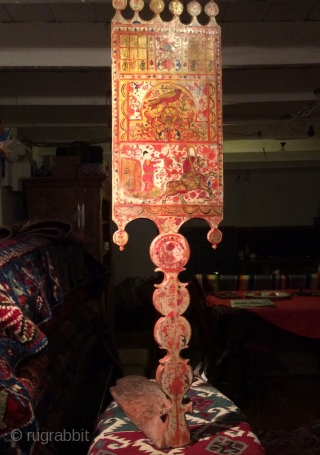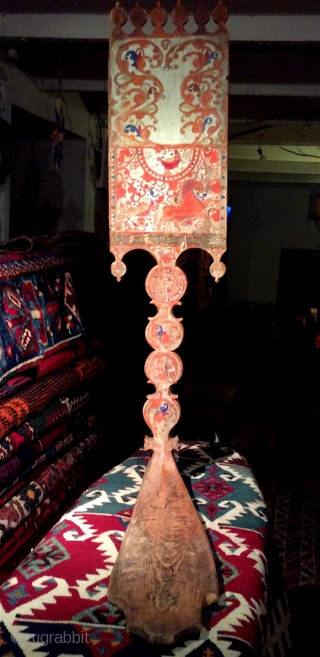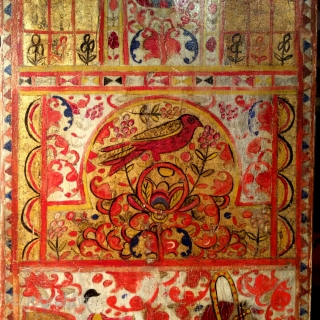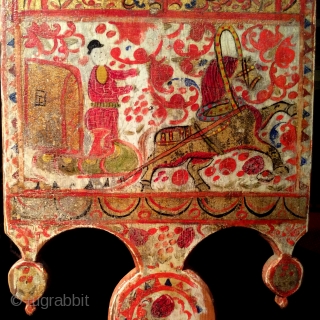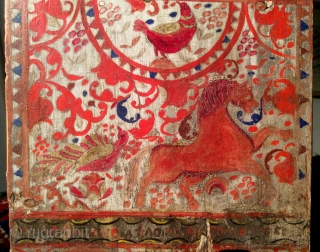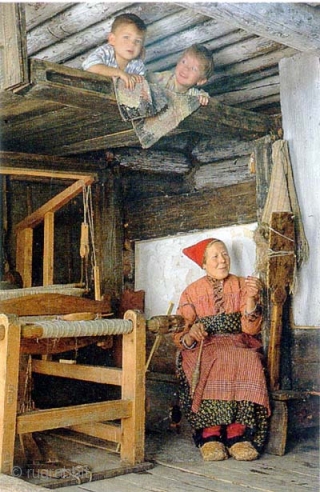Carved from a single piece of timber in the 4th quarter of the 19th century in North Dvina, Borok in the Arkhangel Region of the northern Russian Artic, this distaff was made as a dowry gift for a daughter. The amount of gold used in the paint (which was expensive) reflects the wealth of the family. The tempera painting technique employed and careful preparation of the wood for painting developed from the ancient tradition of icon painting in the region. The character and rendering of the animals, in particular the birds is very appealing (see detailed photos from link).
Here is a description of the different types of distaff from the Sergiev Posad Museum http://www.musobl.divo.ru/Ecolln_tree3.html and here is an article in Russian with photos showing how the distaff was used. The last photo below is from this article: http://subscribe.ru/group/ukraina-bez-politiki/3468017/
The cyrillic text under the main painted panel on the back reads 'Маленькое дело лучше большого безделья' or 'It is better to do a little than nothing at all' Thanks to Оразбай Сампур for helping with deciphering and translation. Size 90cm high by 23cm wide, the foot 50cm long
This is the finest example of an antique distaff outside a museum collection that i have seen.
For more photos please see: http://www.kilim.ie/TRIBAL_ART_AND_ANTIQUES/Pages/Museum_quality_Russian...
Please contact me for more information.
- Home
- Antique Rugs by Region
- Category
- Profiles
- Post Items Free
- Albums
- Benaki Museum of Islamic Art
- Budapest: Ottoman Carpets
- Gulbenkian Museum
- Islamic Carpets. Brooklyn
- Islamic Textiles. Brooklyn
- Konya Museum: Rugs
- MKG, Hamburg
- MMA: Caucasian Carpets
- MMA: Mamluk Carpets
- MMA: Mughal Indian Carpets
- MMA: Ottoman Carpets
- MMA: Safavid Persian Carpets
- MMA: Turkmen Rugs
- McCoy Jones Kilims
- Ottoman textiles. Met
- Philadelphia Museum
- Rugs and Carpets: Berlin
- Seljuqs at the Met
- TIEM, Istanbul: Carpets
- V&A: Classical Carpets
- Vakiflar Carpets: Istanbul
- Baluch Rugs: Indianapolis
- Gallery Exhibitions
- Jaf an Exhibition
- Alberto Levi Gallery
- Andean Textile
- Christie's London: 2016
- Francesca Galloway
- HALI at 40
- ICOC Washington, DC 2018
- Jajims of the Shahsavan
- London Islamic Week April, 2018
- Mongolian Felts
- Navajo Rugs: JB Moore
- Persian Piled Weavings
- SF Tribal & Textile Art Show 2020
- SF Tribal 2019
- Sotheby's: C. Alexander
- Turkish Prayer Rugs
- Turkmen Main Carpets ICOC 2007










